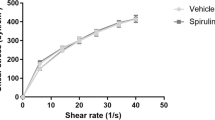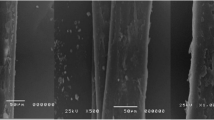Abstract
Human hair and nail are valuable materials for producing individual corresponding biocompatible materials. A rapid and convenient protein extraction method (Shindai method) and novel procedures for preparing their protein films from their extracts have been developed using human hair and nail. The effects of the human hair and nail proteins and their films on histamine release from rat peritoneal mast cells were investigated. Both protein solutions and their films, mainly consisting of keratins and matrix proteins, did not induce histamine release from the mast cells. Scanning electron microscopy (SEM) also showed that the mast cells were only slightly affected by adding the human hair and nail proteins or by incubating on their protein films. The IgE-dependent histamine release was inhibited by the hair and nail proteins and their films. Incubation of the mast cells with the hair and nail proteins prior to the addition of the IgE serum resulted in a high inhibition (50%) of the histamine release, while the inhibition was approximately 10% when the protein solutions were mixed with the mast cells after incubation with the IgE serum. These results suggest that the human hair and nail proteins and their films will be useful materials for antiallergic actions.






Similar content being viewed by others
References
A. NAKAMURA, M. ARIMOTO, K. TAKEUCHI and T. FUJII, Biol. Pharm. Bull. 25, 569 (2002)
T. FUJII and S. MURAI, Kobunshi Ronbunshu 62, 201 (2005)
T. FUJII, D. OGIWARA and M. ARIMOTO, Biol. Pharm. Bull. 27, 89 (2004)
T. FUJII and Y. IDE, Biol. Pharm. Bull. 27, 1433 (2004)
K. YAMAUCHI, M. MANIWA and T. MORI, J. Biomater. Sci. Polym. Ed. 9, 259 (1998)
A. TACHIBANA, Y. FURUTA, H. TAKESHIMA, T. TANABE and K. YAMAUCHI, J. Biotech. 93, 165 (2002)
Y. IDE and T. FUJII, Sen’I Gakkishi 60, 276 (2004)
K. YAMAUCHI, A. YAMAUCHI, T. KUSUNOKI, A. KHODA and Y. KONISHI, J. Biomed. Mater. Res. 31, 439 (1996)
Y. IDE and T. FUJII, Kobunshi Ronbunshu 61, 153 (2004)
T. ISHIZAKA and K. ISHIZAKA, Prog. Allergy 34, 188 (1984)
S. M. MIESCHER and M. VOGEL, Mol. Aspects Med. 23, 413 (2002)
L. J. WALSH, Crit. Rev. Oral Biol. Med. 14, 188 (2003)
T. FUJII, H. YOKOYAMA, G. F. LI and H. TADA, Biol. Pharm. Bull. 20, 79 (1997)
U. K. LAEMMLI, Nature 227, 680 (1970)
M. M. BRADFORD, Anal. Biochem. 72, 248 (1976)
P. A. SHORE, A. BURKHALTER and V. H. COHN Jr, J. Pharmacol. Exp. Ther. 127, 182 (1959)
K. IZUSHI and K. TASAKA, Immunopharmacol. 18, 177 (1989)
B. JANSANI, G. KREIL, B. F. MACKLER and D. R. STANWORTH, Biochem. J. 181, 623 (1979)
A. ARGIOLAS and J. J. PISANO, J. Biol. Chem. 260, 1437 (1990)
H. W. HEID, E. WERNER and W. W. FRANKE, Differentiation 32, 101 (1986)
L. LANGBEIN, M. A. ROGERS, H. WINTER, S. PRAETZEL, U. BECKHAUS, H. R. RACKWITZ and J. SCHWEIZER, J. Biol. Chem. 274, 19874 (1999)
L. LANGBEIN, M. A. ROGERS, H. WINTER, S. PRAETZEL and J. SCHWEIZER, J. Biol. Chem. 276, 35123 (2001)
M. A. ROGERS, H. WINTER, L. LANGBEIN, C. WOLF and J. SCHWEIZER, J. Invest. Dermatol. 114, 464 (2000)
Y. HIRAO, K. OHKAWA, H. YAMAMOTO and T. FUJII, Macromol. Mater. Eng. 290, 165 (2005)
S. KOBAYASHI, H. MORIKAWA, S. ISHII and T. FUJII, JSME Int. J. Ser. C. 48, 494 (2005)
Acknowledgments
This study was supported in part by Grants-in-Aid for Science Research (B) (16350123) and CLUSTER (the second stage) from the Ministry of Education, Culture, Sports, Science and Technology of Japan. We are also indebted to the Division of Gene Research Center, Research Center for Human and Environmental Science, Shinshu University, for providing the facilities.
Author information
Authors and Affiliations
Corresponding author
Rights and permissions
About this article
Cite this article
Fujii, T., Murai, S., Ohkawa, K. et al. Effects of human hair and nail proteins and their films on rat mast cells. J Mater Sci: Mater Med 19, 2335–2342 (2008). https://doi.org/10.1007/s10856-007-3341-x
Received:
Accepted:
Published:
Issue Date:
DOI: https://doi.org/10.1007/s10856-007-3341-x




